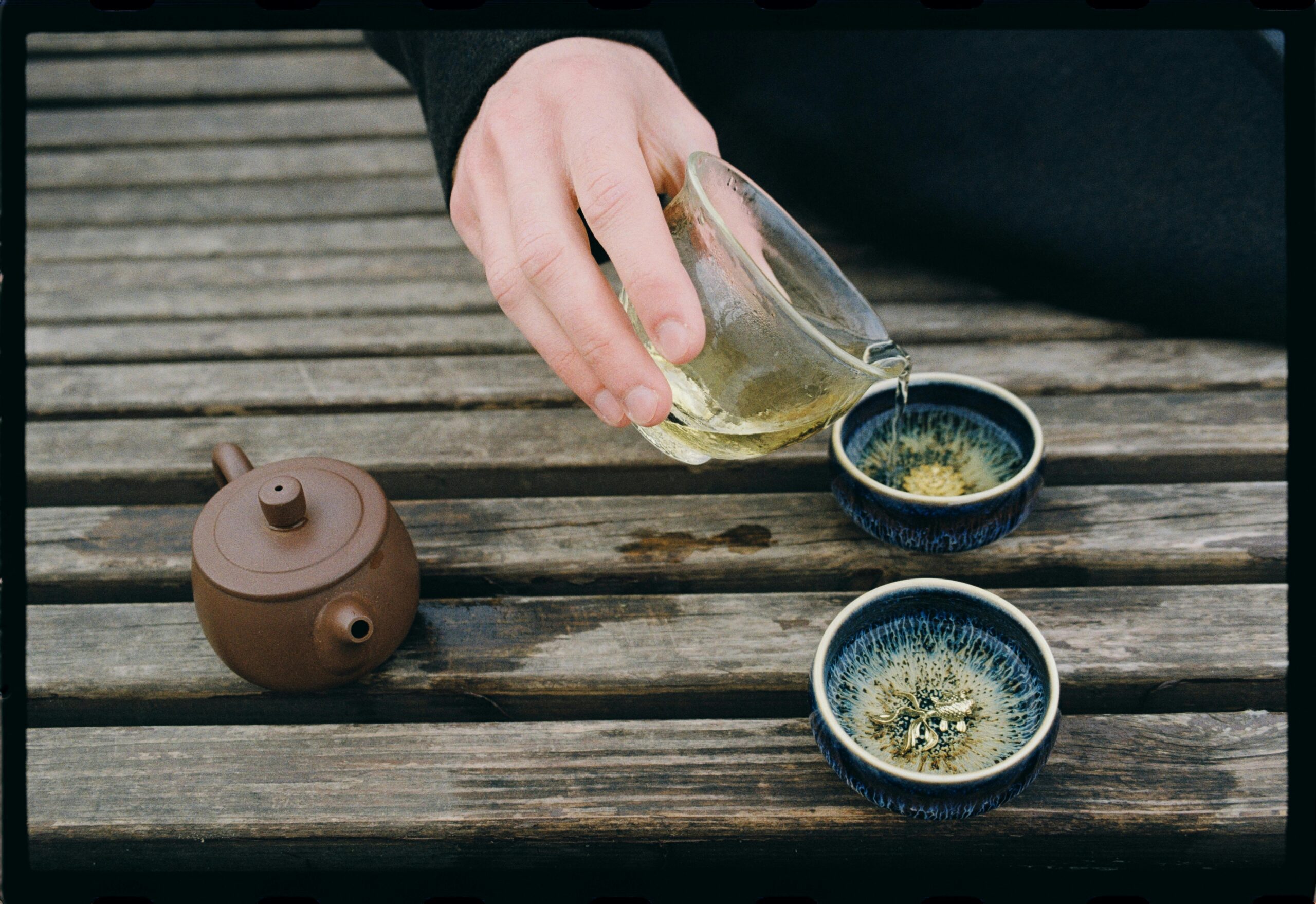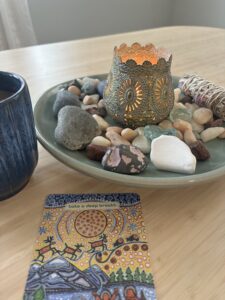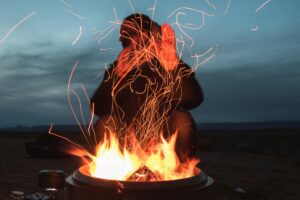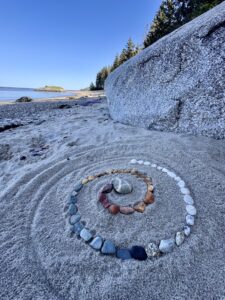
Before I sat down to write this piece, I lit a candle that I love. It’s a little vessel of cut tin, and it throws a pattern of light that gives me a tiny bit of joy. I have the requisite cup of coffee, and I drew an inspiration card for the day. This feels like a ritual to me—something that brings me calm, quiets my mind, and helps me focus on the words that have been collecting in my head all week. Food for thought that I want to share with you. These small acts—lighting a candle, drawing a card, sipping something warm—may seem insignificant, but they help me mark the moment. And that, at its core, is what ritual does.

Rituals.
Why do we do them?
Short answer: Rituals make us feel safe, offer a sense of control, create meaning. They calm the nervous system. Rituals create a sense of predictability, which helps us feel calm.
But What Are Rituals Really?
I felt compelled to look up the literal meaning. Merriam-Webster’s definition of ritual as a noun:
- The established form for a ceremony; specifically: the order of words prescribed for a religious ceremony
- A ceremonial act or action
- An act or series of acts regularly repeated in a set precise manner
In Mara Branscombe’s beautiful book, Ritual as Remedy, she states, “Ritual can be anything that is done with intention. It can be done alone or in a group. … It can give us direct access to our healing, reflect our emotions, and show us how we can access inner transformation and awaken our intuitive power.”
A few years back, a friend of mine told me over coffee and a not-so-healthy snack that her husband eats a small bowl of blueberries and drinks a cup of green tea every night as he reads a book before bed. She was drawing a comparison to our choice of beverage and snack, but what stood out to me was his wind-down ritual. I thought it sounded like a refined and healthy thing to do, and for some reason, this vision has stuck with me over the years. A nightly ritual of self-care, a bit of nourishment for the body, mind and soul. It sounded very appealing and mindful, and I wanted a bit of that for my sometimes-frenzied mind.
Listening To Your Inner Voice
When things get too much, my body and my mind give me cues—sometimes not-so-subtle ones—that I need to slow down and take some time to rest and recharge. Rituals have a way of asking us to take pause, to be mindful, and take a breath. Our nervous systems need this.
Before I moved back out west, a worn out and depressed version of me lit a bonfire in the very early morning hours and burned a whole bunch of old papers, paid bill stubs, ancient tax returns, and poor-quality photos that I had been carrying around with me from move to move for 30 years. The burden of schlepping this pile around with me had come to an end. I used a 30-gallon trash can to heft the stuff from house to fire, over and over, and spent hours adding bits of my history to the fire and continually stoking it with a big stick to make sure it burned down to nothing.
It was just me at that fire, the smoke permeating my hair and clothes, and it was like stepping out of old skin. A cleansing. It was a gut-wrenching move, the end of a marriage, the separation of a family, the end of my long tenure on the East Coast, goodbye to longtime friends, the goodbye to a house I loved. I was mourning the loss of it all, one heap of papers into that fire at a time. Without knowing, I was connecting to something ancestral, ritualistic, and cleansing.
Since the beginning of time, fire ceremonies have been a tool for transformation—burning what no longer serves, offering spiritual prayers, or guidance—a connection to spirit. Ashes to ashes, dust to dust.
Our ancestors used rituals to mark passage. This is handed down in our DNA, our direct connection to our roots. I felt the need to burn all of those old items that day in a way I can only describe as primal.

In Celtic traditions, the festival of Imbolc marked the subtle shift from winter to spring. Fires were lit, homes were cleansed, and offerings were made to the land. It was a ritual of readiness—of tuning in to change before it was fully visible, and preparing for what was to come.
If you were around in the early ’90s, you might remember a quirky, thoughtful TV series called Northern Exposure. Set in the fictional town of Cicely, Alaska, the show followed a big-city doctor transplanted into a remote, tight-knit community full of mystics, philosophers, and oddballs. Beneath the humor, it often explored deeper themes like time, belonging, and our connection to the natural world.
In one memorable episode, the townspeople spend all winter waiting for the moment the river ice finally cracks—a sound that marks the turning of the season. When it happens, it’s not just an audible shift—it’s a deeply felt shift. The town erupts into joy, culminating in a spontaneous potluck celebration at the local bar. It’s human and heartfelt—exactly what ritual so often is: a way to honor change, together.
SUMMER SOLSTICE:
Across time and place, cultures around the world have honored the summer solstice—the longest day of the year—with bold, beautiful, and vibrant celebrations. From bonfires and flower crowns in Scandinavia to circle dances on the plains of North America, the solstice has always been more than just a seasonal shift. It’s honoring life at its fullest expression. Light, color, movement, and song come together to mark the turning point of the sun’s path—reminding us to celebrate what is growing, what is blooming, and what’s possible. Ancient or modern, these gatherings are a ritual and a testament to our shared need to connect—with each other, with nature, and with the cycles that hold us all.
HARVEST FESTIVAL
Late summer or early autumn, these celebrations vary by culture but all share a central purpose: to give thanks for what the earth has provided. The festival marks the end of one cycle and the beginning of another. A time to eat, sing, dance, and pause. These rituals involve symbolic acts—sharing bread, lighting fires, dancing in circles, offering thanks. They focus on abundance, the change of seasons, a connection to nature, community, and spirit. It’s that communal exhale. A time to rest and reflect.
Modern Rituals Are The Same But Different
Ancient rituals often involved ceremony and community, and some modern rituals are no different in that respect. For example:
SPORTS TEAMS
From high school squads to pro leagues, many teams engage in rituals that are repetitive (they happen before every game or event), symbolic, communal, and emotionally charged. Think huddles and chants and even prayer circles to build collective energy. Team rituals do what all rituals do: create safety, create a collective, reinforce loyalty, offer emotional release. Sports teams rely on rituals to unify, focus, and transform. Much like ancient rites of passage, team rituals mark the shift from ordinary to extraordinary.
ICE BATHS
A polar plunge on New Year’s Day—stepping into the ocean after a season marks not only the passage of time but acts as a cleansing, a letting go of what we’ve carried.
And some are quieter, but no less meaningful. They still help us to connect and regulate—to feel alive in our bodies.
NATURE MANDALAS
A quiet, grounding ritual practiced by many seeking connection—to the earth, to creativity, or simply to presence. By gathering stones, leaves, flowers, or twigs and arranging them in circular patterns, we immerse ourselves in a moment of meditation and expression. These mandalas remind us that life is cyclical and ever-changing. Their temporary nature invites us to let go, to embrace impermanence, and to find beauty in balance—even if only for a moment.

Day Schildkret shares in the forward of his gorgeous book, Morning Altars,
“Art, nature and ritual have always offered us a light in dark places.” But it is also a celebration, a feast for the eyes, a show of appreciation for what is all around us. This becomes a ritual if you set about doing it with intention and symbolism. A way to find stillness, process grief, honor our earth, celebrate a milestone— whatever purpose you choose, nature mandalas are a beautiful way to ritualize it.
Rituals are a powerful way to make meaning out of being human. That’s why they’ve persisted for thousands of years—across every culture, age, and belief system. Fire, food, offerings, cleansing, dance, altars, chants, prayer, ice plunges, nature mandalas, blueberries and tea, all of these make us feel safe, included, centered and grounded, and in some way—large or small—transformed. Rituals offer something steady to hold. However you define it, ritual helps us to hold life with a little more care. It reminds us we’re not just moving through time—we are marking it in a meaningful way, together.

Sometimes creating a ritual is as simple as showing up for something familiar—like color on paper on a Saturday morning.
If you’re feeling the pull to begin your own ritual—a gentle one, rooted in stillness and self-expression—I’d love to invite you to join me for Painting in Pajamas.
We meet on quiet Saturday mornings, before the world gets loud. There’s no agenda, no expectation—just a warm space to show up as you are and create something that helps you feel a little more grounded, a little more whole.
Come in your pajamas, bring a cup of something warm, and let your hands do the talking. You don’t need to call yourself an artist. You just need to show up. I hope you’ll join us.

No comments yet.